
Ned Pelger's blog on construction, design and other weirdness. Email him at ned@constructionknowledge.net
Please help him win his readership competition against his son Lex at the Construction Phone Apps Blog
When you work in construction, lighting becomes more reality and less something that happens outside your windows. I’ve always loved to watch lighting, though respect it’s awesome power.
My Dad was an electrical contractor and often got called out in the middle of the night to repair lightning damage…perhaps a well pump that got fried or and industrial motor that was no longer running a production line. He once saw lightning roll along the ground like a ball of fire.
So watch the video below if you like lightning and want to understand it better.
httpv://www.youtube.com/watch?v=RLWIBrweSU8&feature=player_embedded
The Big Dig $15B project in Boston just decided to replace all the florescent light fixtures…at a cost of $54M. A year ago one of the light fixtures crashed to the ground. The investigation found corrosion in the light fixtures that would likely lead to more collapses.
As the Authority evaluated options, they found that a switch to LED bulbs would save $2.5M per year in energy costs. The long bulb life will also save substantial re-lamping and maintenance costs. The selected fixtures are plastic, taking away the corrosion problems.
As you consider your next building project, don’t default to your past lighting decisions. The LEDs have changed so much, you need to consider the best current method to solve each lighting challenge. The lighting revolution offers us a chance to shine. Ignore it at your own peril.
Here’s a handy trick of the trade that allows long extension chords (or other types of long lines like rope or tubing) to be stored in a way that prevents tangles and allows one handed playing out of the stored line.
httpv://www.youtube.com/watch?v=eaEv9wm6gy0
Lex shot me this tip from BoingBoing and the comments noted that this was just a standard crochet knot. That quickly turned into a discussion on guys crocheting (like Rosie Grier) and this comment followed, which cracked me up.
I knit on the trolley down where I live. Maybe I do get shunned by the guys… but ladies love it and it’s a guaranteed conversation starter.
What’s more manly: looking ‘cool’ in the front of the guys, or constantly getting chatted up by beautiful women? 😉
So keep learning new things and don’t be too concerned with looking ridiculous, you may even get chatted up.
Radio signals like mobile phone, Wi-Fi and even satellite TV do a fairly good job passing through stud walls and windows to get into buildings. Over the years I’ve noticed that Pre-Engineered Buildings tend to do poorly with radio signals because the metal roof and walls reflect those radio waves rather than let them pass.
This month’s cover story for PC Pro describes how house construction materials can have a huge effect on your radio wave reception inside the walls. A simple choice of construction materials could lead to many annoying moments inside your new home or office.
The article includes this photo showing a house being constructed with a aluminum foil faced house wrap. The product appears to be Protect TF200 Thermo. From a thermal prospective, this product would be superior to Tyvek House Wrap because it would reflect some thermal radiation back into the heated space along with helping control the air leaks of infiltration. I believe that thermal advantage would be minimal, but the radio interference could be a major annoyance. I will use a Tyvek type product, or building paper, when house wrap is needed in the future.
On office buildings, we sometimes use Thermax cavity wall insulation between the concrete block and the brick. Thermax has an aluminum foil backing that would also reflect radio waves. In the future, I’ll be specifying Styrofoam for cavity wall insulation, to improve the Wi-Fi and mobile phone experience of the future users.
Admittedly I haven’t seen the science on this issue, no real test studies that I know of. But my own experience, as well as my understanding of basic physics, leads me to conclude that I want to avoid foil wraps on walls and roofs when I can. Since products exist that do a similar job at the same cost, I’m going to forgo the (what I think to be slight) thermal benefit in hopes of not messing up mobile phone and Wi-Fi reception.
By the way, if you’re in a home or office that has terrible radio wave reception and discover you have foil backed house wrap or roofing, you are probably up the proverbial creek paddle-less. Since there aren’t any simple fixes, it’s worthwhile to try to avoid the situation on future projects.
Thanks to Kneal for yet again finding items of interest. You are truly the geek’s geek. And, of course, I mean that in the best possible way.
I read a fascinating article this morning in ENR titled Inconvenient Truth: Pittsburgh LEED Gold Building Energy Hog. The article begins as follows:
A first study of the David L. Lawrence Convention Center’s “green building” features has uncovered a quirk in its electrical system that has cost taxpayers $70,000 to $100,000 a year in wasted-power penalties charged by Duquesne Light Co. since 2003.
Known as a “power correction factor penalty,” the extra charge shows the 1.5 million-square-foot center does not run as efficiently as possible and that wasted electricity accounted for 6 percent to 8 percent of its yearly bill, which was $1.27 million in 2010.
“It is wasted energy in a sense,” said Steven Musial, an electrical engineer at CJL Engineering in Moon. “It’s like the foam on a head of beer. A lot of foam is not desirable. It doesn’t do anything for you. The power isn’t in the foam; it’s in the beer.”
The $373 million center’s website touts its LEED Gold rating from the U.S. Green Building Council and includes the slogan “Built Green. Working Green. Every day!” LEED stands for Leadership in Energy and Environmental Design, and the rating is a measure of how efficiently it uses water, electricity and other resources.
The Pittsburg Convention Center’s power factor varied from 0.65 to 0.85, while an acceptable power factor is generally around 0.95. They solved the problem (8 years later) by installing two large capacitors for about $300k.
Initially, I smugly considered how stupid the LEED standard was, then I considered how the buildings I’ve built do regarding their power factor. Truth is, I don’t know. None of the owners I’ve worked for have ever brought it up as a concern and I’ve never checked. I understand the theory of the power factor, shown in my sketch below:
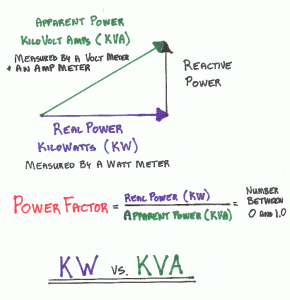 Yet it isn’t something I think about during the design and installation of the electrical system. And I’ve never poured over electric bills from finished projects to see how they perform.
Yet it isn’t something I think about during the design and installation of the electrical system. And I’ve never poured over electric bills from finished projects to see how they perform.
Unfortunately, many items get decided during the design and construction of buildings, but the assumptions don’t get verified and checked during the building operations. Does anyone else have a way that this scenario works? Do you follow up and determine how your buildings actually work?
Seems like there’s an opportunity in there somewhere, though I’m not quite sure how to grab hold of it.
Light Emitting Diode (LED) lights provide low cost lighting with a long bulb life. The LED light uses electroluminescence through the semiconductor to create this light.
Introduced as an electronic component in 1962, the LED lights are just becoming commercially viable for building lighting. I’ve been following the development of these lights for a few years. Until now, they have simply been too expensive to be used except for remote locations that benefited from a super long lamp life.
The LED Waves website shows the large variety of LED bulbs and fixtures available…from the replacement for a 4′ long fluorescent tube to rope lighting. Screw in LED bulbs, dimmable and normal, also are available.
As you are working with Owners, ask them if they want to consider the benefits of LED light bulbs. For many facilities the payback will be viable and it’s a green building option whose time has come. Learn to calculate the payback for evaluating a LED light vs incandescent or fluorescent, it makes you look smart.
Try some LED bulbs in your home or office and see what you think. If you want to be a leader in this industry, keep up with the promising trends.
If you work in construction, you encounter an increasing number of wires and cables in your world. Everyone seems to want more data ports, more phones, more power outlets and more cable TV jacks. My Dad and Grandfather had a small electrical contracting business and had pride in the neatness of their cable runs. I learned at an early age to run the cable straight and true, to care what it looked like even if most other people didn’t.
The assortment of photos at Dark Roasted Blend fascinates me and I thought you would enjoy seeing a few of them. I’ve seen some ugly electric utility company wiring in Third World countries, but this photo from Vietnam takes it to another level.
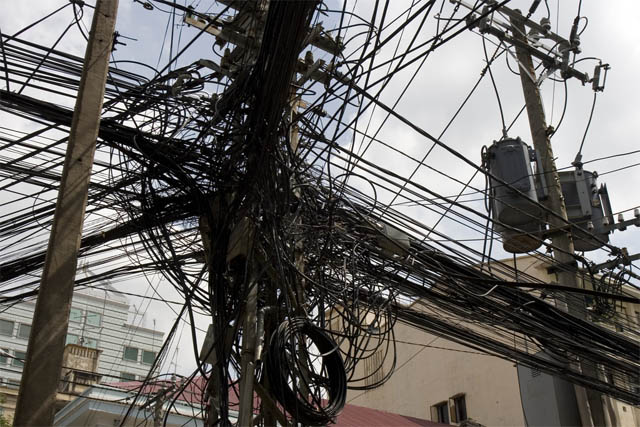
The fact that workers need to get in that mess, as shown below from Nepal, further amazes me.
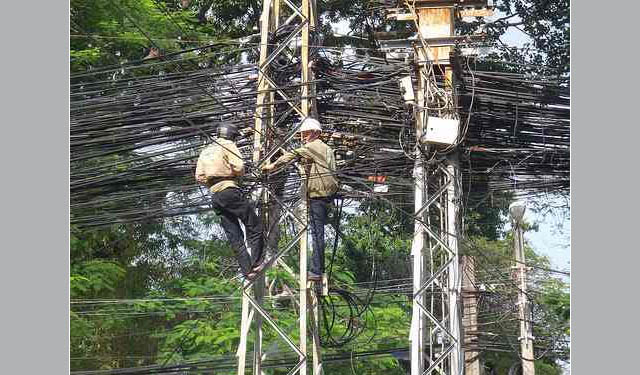
Of course, I don’t get to see that kind of wiring on my job sites, but the phone and data wiring below looks a bit too familiar.
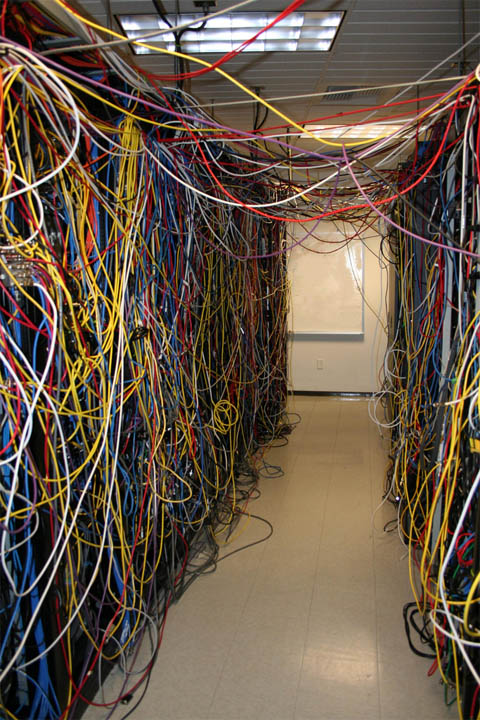

Enough of the crap, the photo below shows what we strive for on our projects.
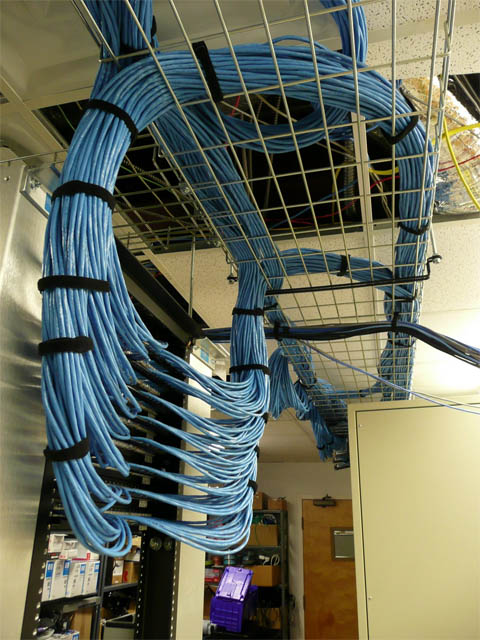
Speaking of crap, though, I saved the best for last. I think this photo takes multi-tasking to a whole new level.
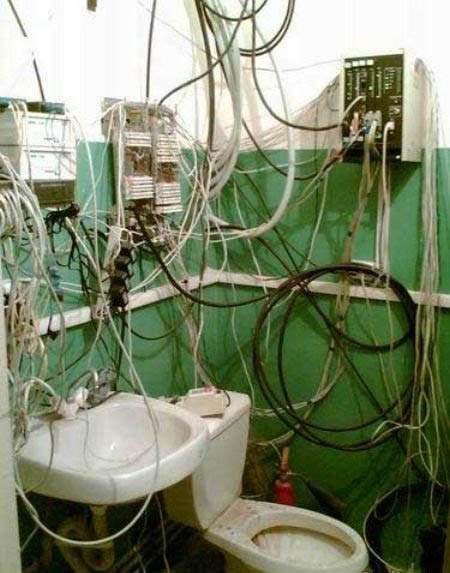
As WC Fields was fond of saying, “It’s time to take the bull by the tail and face the situation.” Buildings have a terrible record for efficient use of energy. The design and construction process for mechanical and electrical systems doesn’t work…well, it does work, but it works to get the lowest first cost and to avoid litigation.
We should be striving to provide systems that cost less to operate and maintain, as well as cost less to install and work well. We need to be looking at life cycle costs, not just what happens in the one year warranty period.
Why are we in this situation? For one, mechanical and electrical (MEP) consulting engineers can’t keep up with all the new technologies. Most of them use the simple design approach they learned when starting in the business and that approach doesn’t handle the complexity of current MEP options.
Also, the goals for building energy use are vague because measurement and reporting has never been focused upon. Search for good standards on how much energy a certain type of building should use and you’ll not find much decent information. This lack of standards for building energy use means no one quite knows what to measure or where the benchmark is.
This disappointing state of affairs presents opportunity. If you are involved in that aspect of the business, you should be learning more about this topic. I guarantee the situation will change dramatically in the next few years. It’s good to be aware of coming trends and position yourself accordingly. If you want to read more about Performance Based Design and Construction, go to AutomatedBuildings.com and read the interview with Tom Hartman.
The march toward real innovation in sustainable design seems slow. Lots of folks copying dim ideas like roof gardens, but few creative approaches that try new concepts. Of course, good design to minimize heat loss, maximize effieciency and provide lots of outside air (Build Tight, Ventilate Right) continues to make sense, but the innovation of big new ideas seems small.
Along those lines, architectural lighting of buildings has always plagued me. The aesthetic value soars, but so do the energy costs. If the owner turns off the lights to save energy, heh, “We’re in the dark here.” I saw some gorgeous, yet efficient bridge lighting that got me thinking.
This article on nine unique bridges highlights the beautiful X shaped cable stayed bridge with two crossed lanes recently completed in San Paulo, Brazil. While greatly improving traffic flow in the city, the graceful towers and cables add a remarkable design element.
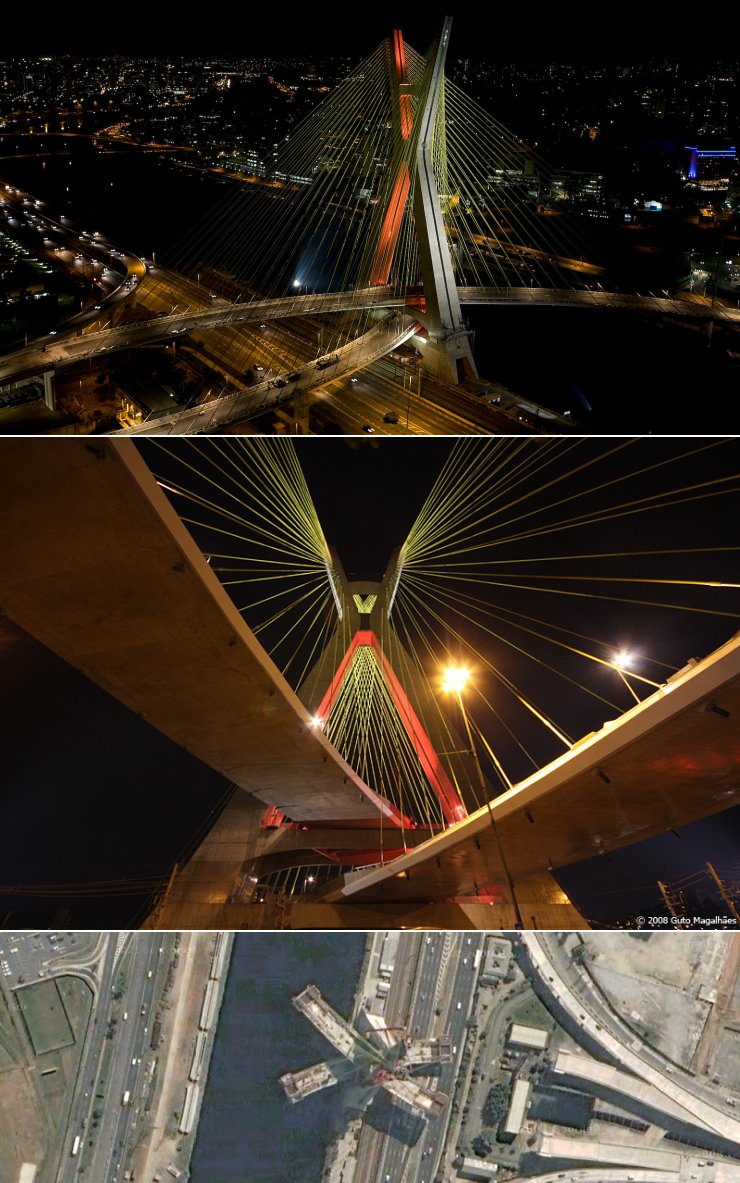
Yet the daytime beauty pales compared to the night view of this marvelous structure. By utilizing an intelligent LED lighting system for architectural lighting, the long term operational and maintenance costs greatly reduce. The video below illustrates (with a cool song as well).
[youtube=http://www.youtube.com/watch?v=-JWa83vzBBE&eurl=http://deputy-dog.com/2008/08/9-amazingly-unique-bridges-you-may-not.html&feature=player_embedded]
The LED lighting system gets further described in LEDs Magazine. I challenge you to think creatively about how the projects you work on can be done in a more sustainable manner. To get your mind moving in that direction, these LEED guidelines are free and help you understand the basics quickly. I encourage you to download the LEED checklists for the type project you’re working on. Review the items and determine if you could suggest any sustainable improvements to your current project.
Remember, Learning Leads to Advancement…and it’s fun to surprise people and make them re-think their assumptions about you.